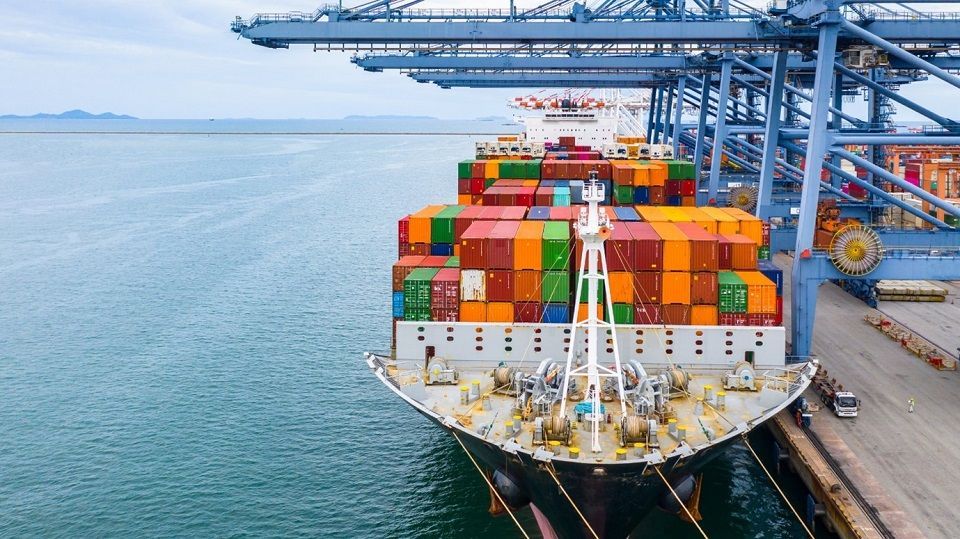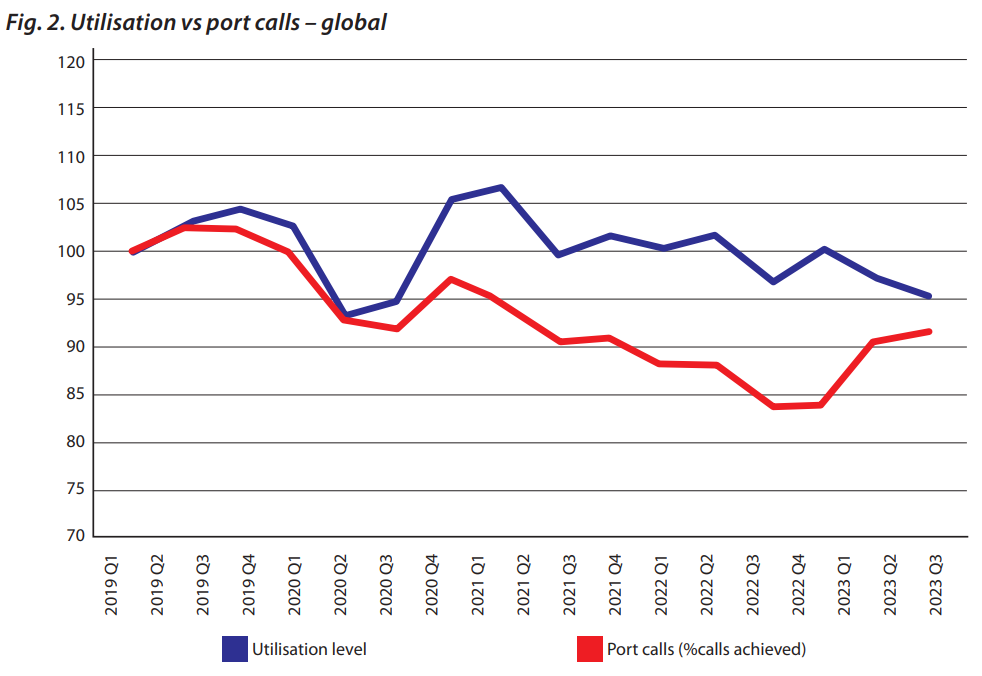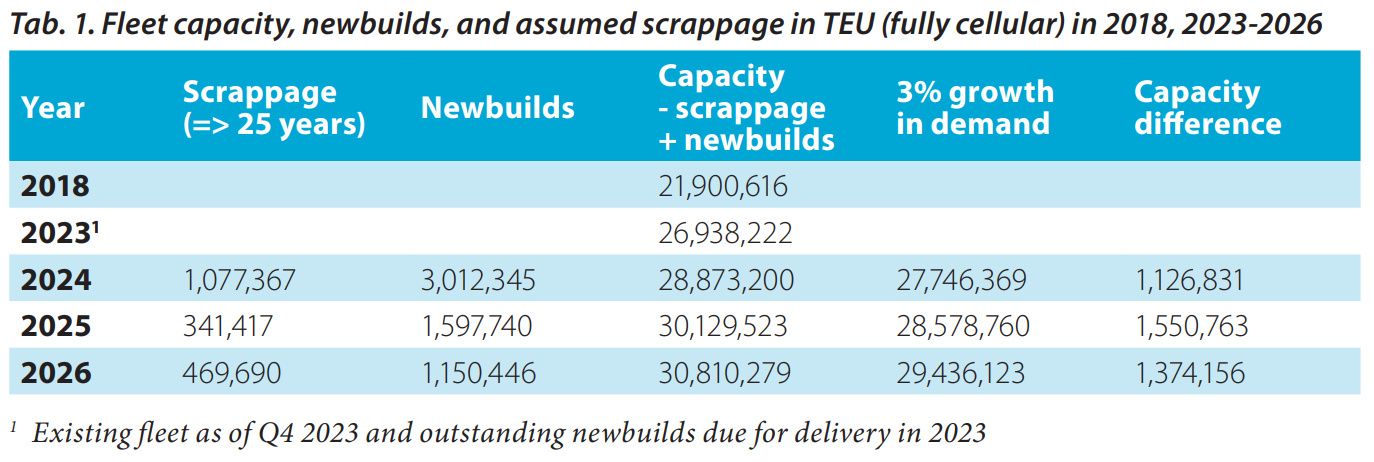Blog Post

The end of the Consortia Block Exemption Regulation: What happens now
- By Mike Garratt and Antonella Teodoro
- •
- 09 Jan, 2024
Someone falling into a deep coma four years ago in December 2019 and re-awakening today might
be forgiven for believing that little had changed in the world of deep-sea containers. Container Trade
Statistics reported a 4.7% growth in global loaded TEU. The Shanghai Containerized Freight Index
was marginally higher. Maersk’s Q3 EBITDA was still around 14% of turnover. Mean ship size was up
by 11%. How misleading those initial observations would have been!

Over those intervening four years,
which incorporated a global pandemic, an initial fall off in traffic had been followed by demand
exceeding supply to such an extent that the
mean freight revenues had nearly trebled by
Q3 2022. Consequently, the lines made enormous profits that were (in part) used to extend
vertical integration into port terminals and
increasingly into door-to-door logistics.
However, having won their case four
years before, the lines had just lost the argument to retain the anti-trust legislation provided by the Consortium Block Exemption
Regulation (CEBR). The UK Competition
and Markets Authority has similarly decided
that the country will not establish its own
CEBR. And there’s the signed & sealed inclusion of much of the shipping industry in the
European Union Emissions Trading System
(EU ETS), effectively raising energy costs to
the lines by 40% for ships sailing between
EU ports (but not if sailing between other
ports – an invitation to develop ingenious
routing if ever there was!).
The age-old supply-demand
(different tune) dance
In so far as demand is concerned, the
trade statistics which feed our World Cargo
Database suggest that while the European
market has been depressed in 2023,
the global pattern of 3% per annum growth
is re-establishing itself; exports from the Far
East are now growing, including to Europe.
We estimate that at its peak, the very high
freight rates that drove as much as 7% of
cargo normally containerised to alternative maritime, air, or overland modes – but
this level of diversion has now been halved.
Figure 1 indexes the changes in scheduled deployed capacity, fleet capacity,
demand, and mean revenue per TEU over
the last few years (with Q1 2019 as the baseline). A supply shortage in late 2020 accelerated rates that peaked over a year later when
fleet capacity was already creating a capacity
surplus. Demand fell back, and only now is
returning to the levels of three years ago.

The impact of the coronavirus pandemic
and the management of fleet capacity led
to the curious feature of utilisation levels
(demand/supply) falling as the number of
ports the lines called at relative to ‘scheduled
expectations’ also fell, a significant slump
in service quality that is only recovering in
the second half of 2023.

Our forecasts for
all deep-sea containerised trades over the
next five years reflect the gradual pick-up in
demand being experienced as 2023 comes to
an end (most marked on the Pacific).

However, this level of growth appears
unlikely to match the additional capacity that has recently and is currently being
built. The lines offered less deployed capacity during COVID-19, which drove rates
up. Ironically, as ship queues and capacity
challenges in the ports have been resolved,
the lines have more ships on order than
demand may justify over the next three years.
Table 1 describes our current estimates
for fleet supply (including newbuilds and
scrappage) and the capacity required to
address a yearly 3% growth in demand
(assuming ships continue to operate at
current speeds in existing strings). If the
way vessels are deployed remains the same,
then we estimate excess fleet capacity to be
around 4.5% in 2026 (1.4m/30.8m TEU of
fleet capacity) compared with today.

In practice, the lines will be able to absorb
some surplus fleet capacity through further
speed reductions to re-optimise given the
impact of the EU ETS, increasing the proportion of the fleet deployed on ‘multi-regional’
services (e.g., Europe-Gulf-Far East), more
lines operating services independently, and
through adding ports to rotations to reduce
feeder costs (and potentially game-play the
EU ETS to minimise nautical miles between
ports in the European Economic Area).
Scrappage may also accelerate.
An important question is the overall
impact that the end of CEBR will have.
MDS Transmodal’s role in this debate
was to provide the European Commission
(COM) with statistical analyses on fleet
deployment and market shares.
Crackdown?
The lines lost the argument to retain
CEBR because COM decided that providing the liner business with anti-trust privileges that exceeded those available to other
sectors did not pass the five tests (of effectiveness, efficiency, relevance, coherence,
and EU-added value) it set
and, crucially,
did not protect shippers (i.e., consumers)
when a crisis occurred.
While a number of European trade associations collaborated to also argue against
CBER
because of the high levels of vertical integration taking place, the most dramatic statement against the lines probably
came from another jurisdiction. President
Biden’s March 2022 State of the Union speech
included this passage:
“See what’s happening
with ocean carriers moving goods in and out
of America. During the pandemic, about
half a dozen or less foreign-owned companies raised prices by as much as 1,000% and
made record profits. Tonight, I’m announcing
a crackdown on those companies overcharging American businesses and consumers.”
So, will this legal change make a difference?
The degree to which the World Shipping
Council campaigned to retain CEBR suggests that it will make a difference. Then
again, it may be that the major lines were
already adapting to a decision they had
anticipated. The 2M Alliance will complete
its break-up in 2025. The very largest carriers
are likely to operate their global networks on
a stand-alone basis or with support from the
smaller players; there may even be a further
consolidation because the nine leading lines
cannot each sustain global networks alone.
While for smaller markets, lines may be able
to make a case that market shares above 20%
are in the wider interest, this will not be the
instance for the larger markets.
The impact may extend beyond the
lines themselves. Page 32 of the COM staff
working paper discussed the relationship
between CEBR and the container terminals
that the leading lines also control, implying
that CEBR also protected the relationship
between lines and these terminals, and its
end could raise questions about the rights of
equal-term access. Such uncertainties may
be compounded where different regulators
(on a trade route) have differing rules; some
(e.g., Singapore) allow up to a 50% market
share for a given consortium.
To raise awareness and to question
Rather than make a firm prediction,
we put forward three potential outcomes.
Firstly, one that does not favour the lines
and to which an excess supply weakens
their position. The uncertainty that may
apply to the relationship between terminals
and lines post-ending of CEBR may play to
the advantage of the non-liner major stevedores, who did not have the leverage to
make super profits during COVID. These
stevedores seek to develop a closer relationship with shippers, which will improve
their ability to provide value-added services
and onward transport services (directly or
by sub-contract). This is already happening; stevedores own companies feedering
containers (DP World – Unifeeder, Peel
Ports – BG Freight Line, Abu Dhabi ports
– Safeen Feeders, etc.), and ports contract
for space with railroad operators. At the
same time, port-centric distribution hubs
secure cargo to an individual port. The
lines themselves come under increasing
pressure to offer the most cost-efficient
services, leading to further consolidation of liner services. Non-vessel operating common carriers expand their port-centric distribution centres and, likewise,
their capacity purchasing from the lines.
Quite clearly, this may not be attractive
to some of the shipping lines. The ability to
make profits by charging an economic rent
to pass through a port will pass to the ports
themselves. The step taken at Jebel Ali is
worth noting, where DP World announced
that cargo owners, not the lines, will pay
terminal handling charges.
The second scenario favours the lines.
If market shares do not exceed 20%, an individual shipping line will continue to vertically integrate (including with terminals,
inland transport services, and door-to-door
logistics). In an environment where scale
economies are crucial, any share less than
20% could, therefore, be uncompetitive, and
a very small number of look-alike global
vertically integrated operators emerge. Ports
whose terminals are not included in such
networks may find it challenging to remain
in the market. Individual lines (and two of
the existing ones already reach this scale)
are supported by a range of sub-contractors
(feeders, third-party logistics, etc.) who are
effectively rate takers; the advantage will lie
with the lines. The relatively broad definitions of markets may be such that within
these, sub-markets remain oligopolistic.
Outcomes may not be so extreme, and
much may depend upon the legal interpretation of the new regulatory environment.
The World Shipping Council may have
a point that change will generate legal uncertainty (but that’s in the nature of change).
Thirdly, a possible course of events in
which nation-states and regulators take
a more proactive approach. Given the problems shippers faced during the pandemic,
the decision to terminate CEBR despite the
position that the lines have taken, and the vast
challenges faced to decarbonise the industry, global bodies may choose to examine
whether the current industry structure serves
the public interest to promote trade. Such
an examination may consider that regular
and reliable liner shipping services should
be seen as a global trading utility, providing
a minimum level of connectivity, frequency
and reliability (including to emerging economies). In these circumstances, it could be that
lines will find themselves being obliged to
offer minimum levels of service to individual
nation-states to be authorised to operate at
ports in their countries.
We do not suggest which, if any, of
these ‘travel directions’ might be followed.
However, one of the effects of the industry’s
reaction to the pandemic has been to raise
awareness of the vulnerability of world trade
to investment and operational decision-making by a relatively small number of companies and to question the level of resilience the
industry offers.
Share
Tweet
Share
Mail
© Copyright 2023 MDS Transmodal. All Rights Reserved.
